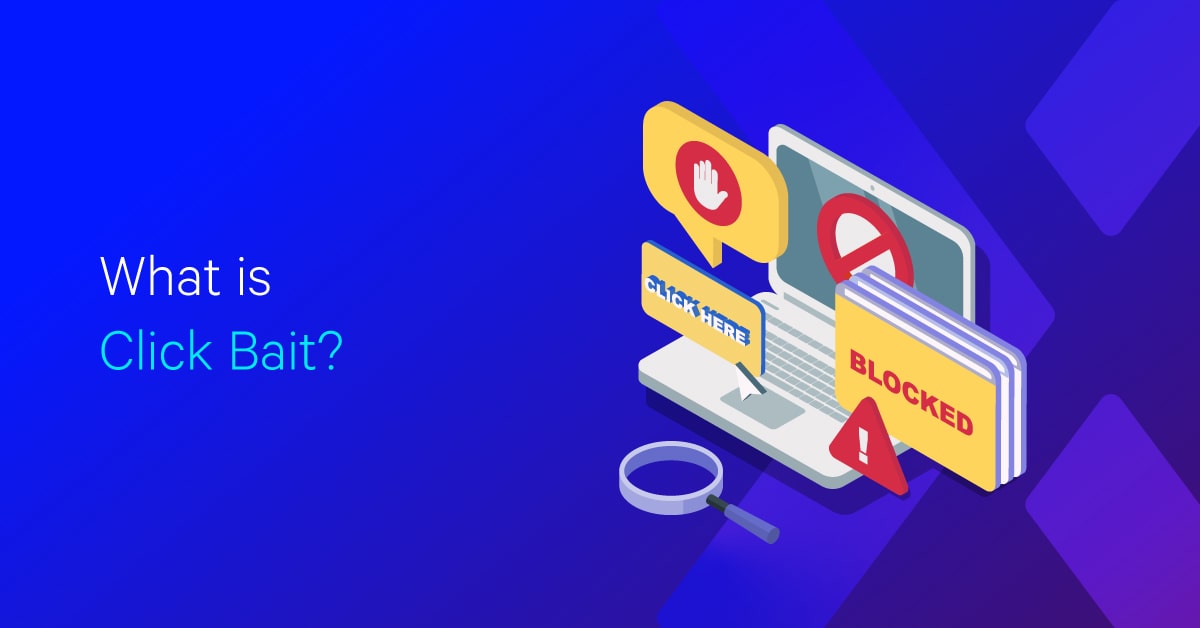What Is Clickbait?

Hand off the toughest tasks in SEO, PPC, and content without compromising quality
Explore ServicesYou’ve undoubtedly seen them, and your curiosity has most likely led you to click on them.
One minute you’re looking up how to use SEO for your e-commerce store online and the next you’re reading an article; “A cat being scared by its shadow. What happens next will shock you”.
Clickbait headlines are intended to pique the reader’s interest and drive traffic to a website.
Generally, traffic is a good thing. Why, then, should clickbait headlines be avoided?
Although clickbait is effective at driving traffic, it does not guarantee a high search engine ranking. In fact, your ranking could fall dramatically.
In this article, we’ll focus on what clickbait is, the purpose of clickbait, what happens when you click clickbait and why clickbait is bad.
“What you’ll discover about clickbait may shock you! #2 Will Change Your Business!”
This time, your curiosity will earn you a good read! Worthy of your time…
Let’s get started!
What Is Clickbait?
Clickbait refers to a sensationalized headline that entices you to click on a link to an article, image, or video. Clickbait headlines frequently appeal to your emotions and curiosity rather than providing objective facts.
When you click on a link, the website that hosts it earns money from advertisers, but the actual content is usually of questionable quality and accuracy. Websites use clickbait to increase ad revenue by attracting as many clicks as possible.
Many marketers and savvy online readers despise clickbait these days, and for good reason: the sensationalistic and hazy headline writing style popularized by sites like BuzzFeed and Upworthy (“This Man Bought his Daughter an Ice Cream. What Happens Next Will Astound You”), developed a new type of content marketing and web writing style that captivated curious readers and audiences all over the world.
In general, it does not have a positive connotation. We tend to associate the phrase with spammy websites seeking traffic at any cost.
According to Merriam-Webster, clickbait is “something (such as a headline) designed to entice readers to click on a hyperlink, particularly when the link leads to content of dubious value or interest.”
Facebook has a similar – albeit slightly more negative – definition: content that is “designed to attract attention and lure visitors to click on a link.” Here’s an example of an article with a clickbait headline:

Why Is Clickbait Important?
So, you’re thinking about creating some clickbait web content but aren’t sure how it will benefit you? Let’s look at some of the benefits of clickbait.
- Increased Opportunity for Social Shares
A good (or effective) clickbait is almost as easy to share on social media as it is to click on it in the first place—link building. People, on the other hand, will not share just anything because the type of content they share on social networks is often closely linked to perceptions of their personality.
It pays to appeal to people’s emotions in order to encourage social sharing of clickbait. The stronger the emotional reaction, the more likely it is that they will share the content.
- Increased Pageviews
As the sole goal of creating clickbait, it should come as no surprise that the first benefit of this type of content is more pageviews. If you only want pageviews, clickbait is a great way to get them.
Using an analytics platform such as Google Analytics, pay close attention to the sources of your traffic, to assess the effectiveness of clickbait on your own website.
- Increased Brand Recognition
The third advantage of clickbait content is increased brand awareness. If clickbait increases pageviews and social shares, it follows that as your content spreads across the web, more people will be exposed to your brand.
Creating compelling clickbait is a great way to increase brand awareness in content marketing. But remember, according to studies, the two most significant signals utilized by Google to rank your website for search are high-quality content and link building.
Clickbait FAQ
What is the purpose of clickbait?
Just as linkbait was (and still is) content intended to entice other sites to link to it, thereby increasing the link profile of the site that published it, clickbait is content designed to attract as many clickthroughs – and pageviews – as possible. More page views usually equate to higher ad revenues, which equates to higher profits for the site’s publishers.
Clickbait employs psychological strategies to manipulate users with provocative headlines, which are supported by a meta description that describes what the page’s content is about, for example, on the thumbnail of an image, which, when hyperlinked correctly, can gain attention and maximize the number of shares.
What is an example of clickbait?
In social media platforms, clickbait is quite common. The basic idea behind ‘clickbait’ is to create a dramatic title for an online article in order to trick people into clicking the link and reading the content.
Here are 5 types of clickbait that are commonly found in our social media, along with examples, below. Keep an eye out for number 4! It’s quite intriguing!
- Surprising/amazing/unbelievable outcomes
This type of clickbait headline functions in two ways. The first section describes the plot, which is usually very catchy. According to the second part, there is more to the plot and the outcome is quite surprising. The bait is in the second part because it tests our imagination by using phrases like “…you won’t believe…,” “…shocking result,” “…too good to be true,” and so on. - Suspicious tales
These are the most common eye-catching links on a website that entices visitors to continue reading. They pique the reader’s interest in the life of someone else, but in a very convincing way. For instance, “Man Wins Lottery!” Following the use of this trick” - A test of your intelligence
To be honest, I’ve been duped by this type of clickbait title not once, not twice, but numerous times. However, who is to blame? … Some of these questions are fun to answer, but the majority of them are simple 3rd-grade math. For example, “Only people with IQs greater than 160 can answer these questions.” Is it possible that you are one of them? “Click here to learn more…” - ‘Tricky’ items
To attract more viewers, they use the term “simple tricks.”
For example “Supermodels apply these simple tricks to look young, click to know what they are” …When you click on the link, you will see the following:
1. Get at least 8 hours of sleep per night
- Exercise on a regular basis; and
- Maintain a positive attitude.
I mean…really!!!
- The frightful stuff
These are manipulative headlines, since they use the ‘fear’ element, and this type of clickbait is aimed at a specific demographic. For example “Six surprisingly common lifestyle habits that will take you six feet under”
And because each of these six items is on a separate page, you must navigate through 6 pages to obtain this rare and valuable information! How cool is that?
P.S. Don’t confuse click bait with link bait!
What happens when you click clickbait?
Consumers should be wary of IQ tests and quizzes that require them to trade information, according to the Better Business Bureau (BBB). Depending on the scam’s goal, a single click could result in a slew of new email or text spam, malicious data mining, or even a monthly charge on your phone bill.
Aside from spammy quizzes, scammers also use clickbait, which are headlines designed to entice you to click and provide your information. Such headlines frequently promise juicy celebrity information and may even be legitimate human interest stories that state, “and you won’t believe what happened next.” While some of those headlines are written by reputable companies who are simply trying to sell products and compete for clicks, others are data traps that erode your privacy.
Clickbait will increase your bounce rate, and algorithms will despise you. There is much debate about how important bounce rates are—because they are so easy to manipulate, Google may evaluate a bounce rate far less than many people fear.
The goal here is to take advantage of what is known as the curiosity gap. In other words, the headline provides just enough information to pique the reader’s interest, but they must click through to the linked content to learn any real information and truly satisfy their curiosity.
Why is clickbait bad?
- Sensationalism is becoming obsolete
The saturation of sensationalist headlines is rapidly approaching its apex, and even ostensibly trustworthy news outlets like CNN can’t stop publishing highly offensive clickbait articles in their news feed in a misguided attempt to drive pageviews. The signal-to-noise ratio has become so skewed that publishers are resorting to increasingly desperate measures to be heard – a situation that cannot be sustained in the long run.
- Deceptive clickbait harms brands and undermines trust
Few things will irritate and erode your audience’s trust faster than purposefully misleading them with fake news. People expect to be taken to content that matches their expectations when they click on a piece of content.
If you intentionally deceive them for the sake of a pageview, not only will they probably bounce away almost immediately, which can increase your web page’s bounce rate. As visitors may also perceive your brand in a negative way as a result. So, if businesses rely too heavily on click-baiting, it can often come back to bite them hard.
- Pageviews aren’t that important
Many content marketers have jumped on the clickbait bandwagon, producing mediocre content disguised as interesting in the hopes of increasing their pageview count. However, these efforts may be futile, as some experts believe that page views are no longer important.
Chartbeat CEO Tony Haile wrote in a Time magazine article that many publishers are shifting away from the so-called “click web,” in which clickthroughs and pageviews are the dominant metrics, and toward what he refers to as the “attention web,” in which audience attention and engagement are becoming the defining metrics of content success.
Be Careful When Using Clickbait
Hopefully, this article has given you a better understanding of clickbait.
With this in mind, think twice before posting clickbait on your website or promoting it on social media. When utilized carefully and intelligently, it may produce good traffic that can help your online profile. This greater visibility comes with a slew of unintended consequences.
However, depending too much on clickbait is a guaranteed way to hurt your SEO, lose social media followers, and erode trust in your company. As a result, you should proceed with caution. Sometimes it pays to resist jumping on the bandwagon — and unless you’re a confident marketer, that means you should avoid click-baiting.
At Loganix, we can help you with effective SEO and content marketing techniques that will increase your brand’s awareness and build relationships with your audience. Schedule a call today?
Hand off the toughest tasks in SEO, PPC, and content without compromising quality
Explore ServicesWritten by Adam Steele on August 11, 2021
COO and Product Director at Loganix. Recovering SEO, now focused on the understanding how Loganix can make the work-lives of SEO and agency folks more enjoyable, and profitable. Writing from beautiful Vancouver, British Columbia.





